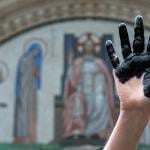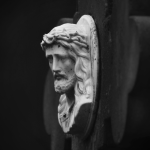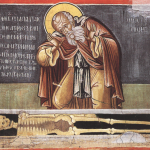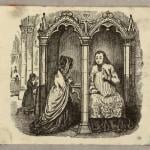OH, HOW THE GHOST OF YOU CLINGS! Notes on Watchmen. So… a while back, I compared Alan Moore and Dave Gibbons’s Watchmen to “Measure for Measure.” Re-reading the book has only strengthened my sense that Moore was using a passel of Shakespearean tics and motives. I doubt that was intentional; they’re the kinds of thing that many writers would try to do, if they were good enough. Both M4M and Watchmen take the conventions of an often fluffy-sweet-melodrama genre (Elizabethan comedy and pre-WM superheroes respectively) and turn them rancid by refusing to ignore or play along with the hidden assumptions–exaggerating what usually gets intentionally overlooked. (Watchmen‘s “happy ending,” like M4M’s, is orchestrated by a powerful schemer and leaves a foul taste.) Watchmen puns constantly, countless pictures and words playing off one another. Sometimes the visual and verbal play just adds a much-needed note of (usually bleak) humor; other times it sets up genuine symmetries and resonances between seemingly disparate characters or situations. And Watchmen shares the Shakespearean obsession with, and jaundiced attitude toward, the craft the artist himself practices (comics or theater) and the art of plotting. Watchmen even shares a characteristic flaw with midlevel Shakespeare: the rich, compelling, often devastating monologue that serves a thematic purpose but throws off the plot’s center of gravity.
There’s so much to say about this comic. I’m going to offer a very disorganized look at some of the book’s themes. I’m making no effort to avoid spoilers–this is a post for people who have already read Watchmen. I loved the thrill of not knowing what came next when I read it, so if you haven’t read it already, I strongly suggest you skip this post and go read it! then come back when you’re done. A couple more caveats: I haven’t read any other long pieces about Watchmen, partly because I haven’t found any and partly because I’m lazy. If people have good essays (especially but not exclusively online), let me know. Also, of course, let me know if you think I’m missing or misconstruing something. …And I am doing this all from notes and memory, because I stupidly lent my copy out before writing this post! But my notes are pretty thorough. OK, let’s go.
“With a Little Kiss, Like a Signature”: One of the most astonishing things about Watchmen is that, although it’s usually treated like a philosophical or at least aesthetic tract, each of its characters has full humanity. (Veidt may be the necessary exception.) One of Jon’s first, and most affectionate, memories of Laurie Juspeczyk is of the unique, personalized way she kisses; each of Moore’s prominent characters feel similarly individual. Each is a world entire.
Watchmen is Shakespearean yet again, insofar as it does not try to present the author’s One True Vision of the world; it merely presents one world, our world the way it might be, and lets us make up our own minds whether this is our world the way it is. Moreover, it presents several equally persuasive interpretations of the world of the book, and again does not try to sway us to one side or the other with special pleading. Characters even present more than one opposing worldview within the book, while remaining believable, consistent characters. Jon’s affirmation of the worth of an individual human life, when he speaks with Laurie on Mars, conflicts with his remote, utilitarian acceptance of Veidt’s scheme at the book’s climax; but both these moments feel like they came from the same character, a being shifting between Jon Osterman and Doctor Manhattan. Rorschach’s denial of any intrinsic meaning to the patterns and suffering in life, in his speech to Malcolm, is more obliquely in conflict with his actions at the climax (in which he seeks to uphold an absolute vision of justice that implies conformity to a preexisting, objective pattern), but again both moments feel utterly true to life. If we allow for the necessarily high-contrast, highly distilled nature of art, we can say that people really do behave the way Moore’s people behave, and their questions and the evidence they work with are ours as well.
Shakespeare gives no hint as to whether “Lear” or “Hamlet” or (the vastly underrated) “Love’s Labour’s Lost” presents the world as he thinks it really is; and he has no responsibility to do so. Similarly, Watchmen is a realistic picture of the world, and anyone who wants to come up with theories about “what is to be done” and what we owe each other and whether there is a God needs to grapple with the fact that the world presented in the comic is utterly believable.
The characters are often played off one another, and there’s a lot of subtlety in the echoes Moore sets up. Take the trio of Rorschach, Comedian, and Veidt. After the Keene Act, neither Rorschach nor the Comedian quit; Rorschach went vigilante and the Comedian signed up with the government. They’re the only two costumed heroes (um, I’m not counting the “superhero” Dr. Manhattan, because everyone in the book views him as a different breed of cat entirely) in the book who do not at least give the appearance of quitting. Rorschach also refers to the Comedian, early on (but late enough that we the readers know better!), as “a better class of person.” Uh-huh. There’s one important similarity between the two: The Comedian and Rorschach both strongly disapprove of Veidt’s plan. Their bloody-mindedness won’t excuse that level of utilitarian carnage. The Comedian kills for selfish reasons and as an act of nihilism; Rorschach kills out of merciless justice; but neither one of them is a twentieth-century-style blood-soaked utopian. As for Veidt, Rorschach looks down on the advertiser, but when he visits Veidt he comes literally with hat in hand. And notice that Rorschach and Veidt are the only characters who never doubt their course.
Fearful Symmetries. Watchmen actually performs the “Hamlet” transformation–using a genre’s tropes to make metaphysical points rather than merely move the plot machinery around–on two genres: superheroes, of course, but also murder mysteries. The superhero stuff has gotten the most attention, but in my opinion the infusion of existential questions into the murder-mystery tropes is more crucial to the book.
On the most basic level, the mystery–who killed the Comedian?–lets the comic hammer its thematic points home pretty hard while keeping us occupied with trying to figure out who’s attacking and killing costumed crimefighters. It takes a long time before we even notice the thematic elements of the mystery.
Probably the biggest theme in Watchmen is interpretation of patterns: What do you see? What is the meaning of life? There are patterns–“symmetry” is both symbol and technique, from Rorschach’s face mask to the way each chapter (and the book as a whole) opens and closes with variations of the same image. But the pattern is very hard to see. Rorschach’s name is key, of course. The very fact of a detective named Rorschach ought to clue you in (heh heh) to the centrality of this theme.
Three speeches approach this theme from different angles. I’ll talk more about Rorschach’s speech to Malcolm the egotistic psychiatrist and Jon’s talk with Laurie on Mars later. The third, though, is Veidt’s soliloquy in Antarctica, which is exclusively concerned with the process of teasing order out of chaos. Veidt’s talent is pattern-spotting and pattern-manipulating. Veidt believes that the patterns do have meaning–but that meaning imposed by powerful, responsible individuals like himself. Patterns are there to be taken advantage of.
Veidt is the book’s plotter, so he stands parallel to Alan Moore. Within the narrative, Veidt creates many of the symmetries and links Moore put in (Pyramid, Gordian Knot, the Nostalgia motif); it’s not clear whether he creates or merely notices the symmetry between the trackless Antarctic wilderness and the moral wilderness into which he’s thrust Dan, Laurie, and (seemingly) Rorschach. And Veidt’s plot–his scheme–is the skeletal structure of the book‘s plot, of course. Rorschach’s symmetrical costume makes him another parallel for symmetry-creating Moore. The advertising theme in Watchmen is echoed in A Small Killing (and the Nostalgia and Millennium ads are good!–evocative), and here the parallel between Moore and the advertiser is much clearer. I’ll note also that Veidt’s plan brings together (on the island) high art, pulp culture, and advertising, suggesting that there’s not that much distance between the three.
With Great Power… comes the temptation to take responsibility for others. Moore reverses the classic superhero shtik–power is thrust upon you and so you have to save everyone. Instead, he says, power is seized by those whose darker motives push them to save others because they can’t do jack for themselves. The offices of the ex-superheroes are creepy-pathetic–those of both Hollis Mason (“Obsolete Models a Specialty”) and Adrian Veidt (surrounded by posters and toy versions of himself). Our first visit to Hollis’s shop is only a couple panels before the first shot of the “Nostalgia” ad (although we don’t see the tagline then). In our first sight of the Nite Owl costume, it’s erect and bigger than Dan is. This has been perhaps the most obvious aspect of Watchmen and so I’m not entirely sure what more I can say about it. Veidt’s attempt to manipulate the world is wrong; but so too is Dan and Laurie’s abdication of responsibility. They could have told everyone about the plot, and they don’t. It’s understandable, but hardly admirable.
Finally, the straightforward, garish style of the art–such pretty women’s legs!–helps fit the comic into the genre it’s breaking. A darker or more experimental style wouldn’t work, since it would too quickly and easily distance Watchmen from primary-colors superhero comics rather than letting that distance emerge through the story.
“Would You Like to Add a Rider?” The visual/verbal punning doesn’t just provide a few laughs in the midst of a grim story. It also serves to intertwine past and present (another major subtheme: the past’s echoes–from “Nostalgia” to “Spirit of ’77” to Jon’s trip to the abandoned nuclear base to the entire Silk Spectre subplot). It links and contrasts “fiction” (fictional stuff within the book, like the pirate comic), plots and narratives created by the characters (mostly Veidt and Rorschach), and “reality” (the stuff that happens in the book). And the puns often link characters to one another: For example, at one time or another almost every major character is compared to or echoed against the pirate in “Tales of the Black Freighter.”
Finally, the wordplay-with-pictures allows Moore to show that the same statements can have totally different meanings coming from different people in different contexts. Again, the comic is full of Rorschach tests: What do you see?
The pirate comic is the most obvious example of linkage. It doesn’t function in Watchmen‘s plot as “The Mousetrap” does in “Hamlet,” but it does or should affect readers’ understanding of Veidt’s plan and the role of hope in the book. The pirate comic is a story of despair as a self-fulfilling prophecy: The castaway assumes that the black freighter’s crew has devastated his hometown, and so he himself causes the carnage he feared. Veidt assumes that without his hideously gory intervention, the world will end, and so he himself causes the book’s greatest destruction. I am pretty sure that part of the point of the pirate comic is to suggest that Veidt is wrong, that his deadly plan was not the only way to prevent World War Three. (A few people have suggested that Veidt’s plan is obviously stupid, and so Dan and Laurie look dumb for thinking it could work. I suppose you could point to the notable lack of other countries rallying around the US much after 9/11; but in Moore’s defense, the US did ally with the USSR to fight Nazis, so there’s precedent for a common enemy overcoming major hostilities. It’s not unthinkable, and worth the suspension of disbelief. Dan and Laurie also see the plan apparently starting to work, as they watch Veidt’s bank of television monitors. So their decision to go along with it, while definitely an exhausted capitulation, is understandable.)
It’s important, too, that the pirate comic is grisly. It’s easy to think of death in superhero comics as either action-movie meaningless cannon fodder, or temporary downtime before the inevitable resurrection. The pirate comic, woven throughout the main narrative, lends a cold sense of impending disaster and visceral destruction that allows Moore to make Veidt’s attack on New York really powerful without having to show a lot of blood and guts. Instead of going for a splatterfest in an attempt to shock us into taking the attack seriously, Moore prepared us throughout the book and let his pirate comic’s gore seep into our response to the “real” attack. The physical horror of the pirate comic would probably seem over the top, gross for its own sake, if it happened in the “real” narrative, but as a sub-narrative it effectively adds to the sense of dread and the smell of blood that hangs over Watchmen. (The pirate comic is especially effective at heightening the sense of foreboding when Dr. Manhattan leaves Earth.)
“Why Does One Death Matter?” That’s maybe the biggest recurring theme or question in the book. Rorschach’s speech to Malcolm argues that there is no meaning to the patterns, that there is only death and horror–the reverse of Laurie and Jon’s interaction on Mars. And both are predicated on female pain (the little girl; Kitty Genovese; and Laurie herself). Including Kitty Genovese isn’t just a cheap use of other people’s pain. It’s an act of force on Moore’s part, allowing no escape for the comfort-seeking reader. It’s the reason Dostoyevsky used real newspaper accounts of tortured children to shape the “Rebellion” chapter of The Brothers Karamazov.
A woman’s pain is crucial to one of the other key moments in the development of this theme: the moment when Doctor Manhattan does not intervene when the Comedian kills the Vietnamese mother of his child. This moment foreshadows his decision not to intervene to stop Veidt. His decision to return to Earth turns out to rest on attachment to Laurie, not to individual humans as such. (“Love of one is always a barbarism–the love of God, too,” as Nietzsche says.) Laurie and Dan expect him to be the deus ex machina (more punning–he gets his powers while trapped within a machine), but he refuses. Except this time it’s not just not acting–he has to affirmatively side with Veidt by killing Rorschach. As John Jakala pointed out somewhere I can’t find on Google, just as Laurie’s pain at learning who her father is prompts Jon to return to Earth, so murdering Rorschach severs his final ties to humanity. One death matters, but it might not matter the way you expected it to….
Watchmen features two unsuccessful replacement gods: Ozymandias and Dr. Manhattan. But what is it they were supposed to do? Were they supposed to prevent suffering? That’s precisely what they tried to do, with the necessarily imperfect knowledge and understanding that even wildly intelligent or semi-transtemporal created beings are heir to. In order to fix everything, to remove conflict and suffering, the replacement gods mistrust and destroy ordinary humans. I don’t think that this can be pushed too hard, but I’ll note here the parallel with a fairly basic Christian response to the problem of evil–to force us to love is to remove our ability to love; to remove our capacity for evil is to make us robots, not humans, and ultimately to destroy us for our own good.
“Ordinary People…” Just as Rorschach’s justice-without-mercy role is taken on due to female pain, so the only instances of mercy in the comic are undertaken by women. Sally Jupiter forgives the Comedian; then Laurie Juspeczyk forgives her mother; and Malcolm’s wife forgives him. I’m pretty sure these are the only examples of explicit forgiveness shown in the comic. I think that’s why it ends, in a seemingly too-easy way, with the Silk Spectre. Women seem marginal to the world of Watchmen (even Laurie), but they’re central to its theme–which is, I hope, an intentional statement about what is overlooked by fantasies of universal justice. Women, who have so often been “wounded in the house of a friend”–suffering intimate violence–might be more able to articulate or represent the terrible price of either justice without mercy or mercy without justice than a male character would be.
There’s so much I haven’t touched on here–to take just one example, there’s the theme of joking or laughter. The Comedian; Rorschach’s last words (“Joking, of course”); the man with the fake breasts. Maybe I’ll talk about that stuff later. If you all want to take that up, PLEASE do…. The email link is to your left!











